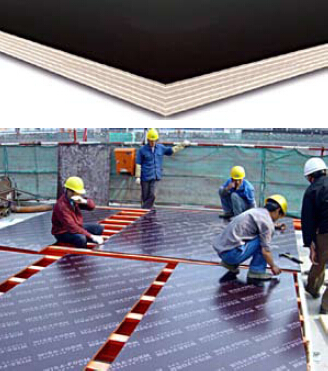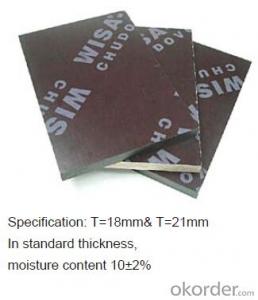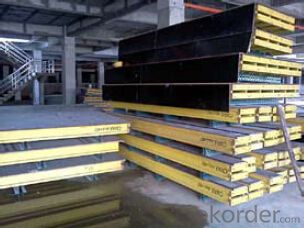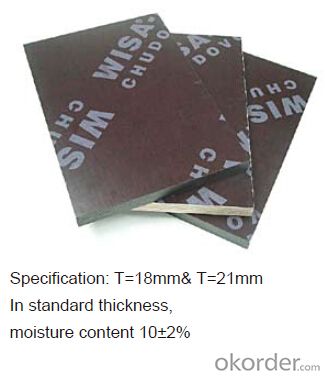Plywood Formwork systems for formwork and scaffolding
- Loading Port:
- Tianjin
- Payment Terms:
- TT OR LC
- Min Order Qty:
- 50 m²
- Supply Capability:
- 1000 m²/month
OKorder Service Pledge
Quality Product, Order Online Tracking, Timely Delivery
OKorder Financial Service
Credit Rating, Credit Services, Credit Purchasing
You Might Also Like
Plywood --- make perfect concrete surface
WISA-Form Birch is a coated special plywood using in the formwork systems where high
requirements are set on the concrete surface and the times of reuses.
With CNBM timber beam & WISA plywood, the formwork is low weight but high load capacity, it is
widely used in construction.
Characteristics:
◆ Component with high standardization.
◆ Assembling in site, flexible application.
◆ Light weight, easy transportation and storage.


- Q: What are the different types of concrete finishes achievable with steel formwork?
- There are several types of concrete finishes that can be achieved with steel formwork, each offering a unique aesthetic and functional appeal. 1. Smooth Finish: Steel formwork can create a smooth finish on the concrete surface, which is often desired for applications such as walls, floors, and countertops. This finish provides a sleek and polished look and is achieved by using high-quality formwork materials and meticulous installation techniques. 2. Textured Finish: Steel formwork allows for various textured finishes to be achieved on the concrete surface. These textures can range from subtle patterns to more pronounced designs, offering visual interest and enhancing the overall appearance of the concrete. Textured finishes are commonly used in architectural applications to create a visually appealing and distinctive look. 3. Exposed Aggregate Finish: With steel formwork, it is possible to achieve an exposed aggregate finish on the concrete surface. This finish involves removing the top layer of the concrete to expose the aggregates, such as stones or pebbles, embedded within. Exposed aggregate finishes are popular for driveways, walkways, and decorative concrete applications, as they provide a natural and textured appearance. 4. Stamped Finish: Steel formwork can be used to create stamped finishes on the concrete surface, mimicking the appearance of materials like brick, tile, or natural stone. This technique involves pressing molds or stamps onto the concrete before it fully sets, leaving behind imprints that resemble the desired pattern. Stamped finishes are commonly used for patios, pool decks, and other outdoor areas, as they offer a cost-effective alternative to natural materials. 5. Acid Stain Finish: Steel formwork can also be utilized to achieve an acid stain finish on the concrete surface. Acid staining involves applying a chemical solution that reacts with the concrete, creating unique and translucent colors. This finish is often used in commercial and residential spaces where a more rustic and earthy look is desired, as it can enhance the natural variation and character of the concrete. In summary, steel formwork allows for a wide range of concrete finishes to be achieved, including smooth, textured, exposed aggregate, stamped, and acid stain finishes. Each finish offers its own visual and functional benefits, allowing designers and architects to create customized and appealing concrete surfaces for various applications.
- Q: How does steel formwork handle formwork stripping and cleaning?
- Steel formwork handles formwork stripping and cleaning efficiently due to its durability and strength. It can withstand the pressure and force exerted during the stripping process without getting damaged. Additionally, steel formwork is easy to clean as it has a smooth surface, allowing for quick and thorough removal of any residual concrete or dirt. Its robust nature and low maintenance requirements make it a preferred choice for formwork stripping and cleaning in construction projects.
- Q: Can steel formwork be used for both single-sided and double-sided forming?
- Yes, steel formwork can be used for both single-sided and double-sided forming. It is a versatile and durable material that can withstand the pressure and weight of concrete on both sides, making it suitable for various construction applications.
- Q: Can steel formwork be used for both straight and sloping structures?
- Yes, steel formwork can be used for both straight and sloping structures. Steel formwork is a versatile and flexible construction material that can be customized to fit various shapes and configurations. It can be easily adjusted and secured to create straight walls and columns. Additionally, with the use of specialized accessories and components, steel formwork can also be adapted to create sloping structures such as ramps, inclined walls, and curved surfaces. This flexibility and adaptability make steel formwork a preferred choice for construction projects with varying design requirements.
- Q: How does steel formwork contribute to the overall stability of a structure?
- Steel formwork contributes to the overall stability of a structure by providing a robust and rigid framework for concrete placement. Its strength and durability prevent deformation or displacement during the pouring and curing process, ensuring the concrete sets in the desired shape and position. This stability allows for the proper alignment and distribution of loads, enhancing the structural integrity of the building and reducing the risk of any potential structural failures.
- Q: Is steel formwork suitable for all types of construction projects?
- No, steel formwork may not be suitable for all types of construction projects. It is commonly used in large-scale projects that require repetitive use of formwork, such as high-rise buildings or bridges. However, for smaller or more intricate projects, other types of formwork materials like wood or plastic may be more appropriate. The choice of formwork depends on factors such as project size, complexity, budget, and specific requirements.
- Q: Does steel formwork require any special tools for installation and removal?
- Yes, steel formwork typically requires specialized tools for installation and removal. These tools may include adjustable steel props, formwork clamps, formwork wrenches, and hydraulic jacks. These tools are necessary to ensure proper alignment, stability, and to facilitate the efficient assembly and disassembly of the steel formwork system.
- Q: Production of steel plate for bridge steel plate SPHC and Q235 which material is good? What is the difference?
- Represents the hot rolled steel plate (which corresponds to the cold rolled plate is SPCC)
- Q: Can steel formwork be used for precast concrete columns?
- Yes, steel formwork can be used for precast concrete columns. Steel formwork offers durability and strength, making it suitable for creating precise and complex shapes required for precast concrete columns. Additionally, steel formwork can be reused multiple times, making it a cost-effective option for precast concrete column production.
- Q: What are the different types of steel connectors used in steel formwork?
- There are several types of steel connectors used in steel formwork, including wedge bolts, tie rods, formwork clamps, anchor nuts, and wing nuts. These connectors play a vital role in securing and stabilizing the formwork system, ensuring the structural integrity and safety of the concrete construction process.
Send your message to us
Plywood Formwork systems for formwork and scaffolding
- Loading Port:
- Tianjin
- Payment Terms:
- TT OR LC
- Min Order Qty:
- 50 m²
- Supply Capability:
- 1000 m²/month
OKorder Service Pledge
Quality Product, Order Online Tracking, Timely Delivery
OKorder Financial Service
Credit Rating, Credit Services, Credit Purchasing
Similar products
Hot products
Hot Searches
Related keywords


















